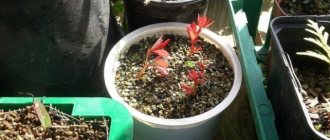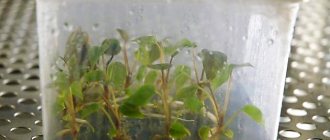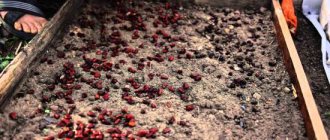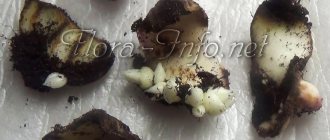Croton is an extremely interesting plant. A strong, beautiful tree or fluffy shrub with bright, colorful leaves of a fancy shape can decorate not only your home, but also be your friend in your study or office. For these purposes, one flower is not enough, so it’s time for you to think about propagating croton at home.
There are several ways to propagate croton: seeds, cuttings, leaves and air layering.
Croton propagation by cuttings
Propagation by cuttings is most popular among Croton owners. Well-ripened cuttings 8-15 cm long, which are cut from the main or side stem, are suitable for it. This process is best done in late winter or spring, when there is more sunlight, although at any other time of the year cuttings can be successfully rooted using fluorescent lamps.
Croton cuttings
The lower leaves are cut off from the prepared shoot, the milky juice released from the wound is washed off under water, blotted with a napkin, sprinkled with charcoal and the cutting is allowed to dry for at least a couple of hours. The remaining leaves on the shoot are tied into a tube; the top leaves that are too large can be cut in half so that the cutting does not lose all its moisture. A well-dried cutting is planted in a prepared container with drainage and a mixture of sand and peat, covered with a film with holes for ventilation and placed in a warm place with diffused lighting. The shoots will begin to grow in about a month. Almost all types of crotons are propagated using this method. The remaining parent tree, after cutting the cuttings, will certainly grow new shoots.
Rooting Croton in water
You can try to root croton shoots in warm, settled water, the temperature of which is 25-27 °C in summer; this method is most effective. At other times of the year, you need to monitor the temperature of the surrounding air and water in the container with the cuttings. If the water cools for a long time, then root formation first slows down and then stops altogether. The seedling will rot and die. In warmer water, above 30 °C, there is a high probability of bacterial flora developing. When strong white roots 2-3 cm long appear, the seedlings can be transplanted into a prepared container under a film for subsequent rooting. The temperature during the rooting period should remain high, about 25-27 °C. We must ensure that the soil does not dry out. The lighting should be bright but diffuse. Daylight hours are long. After a month, the shoots usually take root well, and they need to be transplanted into a prepared pot with drainage and a nutrient mixture. When the flower becomes crowded and the root system fills the pot completely, the croton will need to be transplanted into a larger pot with a diameter of 13-15 cm.
This may be interesting: Tradescantia - home care
Types and varieties
Under natural conditions, there are several dozen species of croton, but only variegated croton is suitable for growing in an apartment. Several varietal hybrids were bred from it.
Codium variegated, or Codium variegatum. This is the ancestor of all cultivated varieties. In nature, it can be a tree up to 4 m high or a bush up to 150 cm high. But in an apartment, the plant grows 0.5 m long. It has large foliage up to 30 cm long. The leaves grow alternately on the stem.
Peter's codiaeum. The bush is up to 1.5 m in height. It has large green leaves with yellow veins, which makes the plant decorative. The veins may also be pink. The foliage is located alternately on the shoot and turned in different directions, so the crown is very lush.
Codeium Excellent. It has very beautiful decorative leaves, they are green on top with yellowish spots, and below the color gradually flows into crimson. The longer a plant lives, the more shades the leaves have, the more tints of orange, pink, and red. Brown veins are also clearly visible on the leaves. The foliage is shaped like oak leaves and has bright veins. The leaf has a base and 2 blades. Gardeners love to grow this variety.
Croton variety Gold Sun. The plant is compact, its height is approximately 30 cm. It has green foliage with yellow veins.
Codium Mix. This is a collection of various varieties. The length of the leaves is from 20 to 30 cm. They have a variety of colors, they can be green, yellow, pink, or bicolor.
Choosing codiaum when purchasing
Carefully inspect the plant to ensure that it is not diseased or has pests, as the crop is often affected by scale insects and spider mites.
To do this, carefully examine the underside of the leaves and their axils. The foliage should be bright and shiny. Make sure that the foliage is not curled, as this means that there are pests on the flower.
After purchasing the plant, water it immediately. Do not remove the transparent packaging for a week, then there will be a microclimate inside it that will help the flower take root. Quarantine the plant for a month, placing it separately from the others.
Croton: description, care and reproduction. Video:
Croton propagation by leaf
You can also try rooting a stem cutting with a single leaf, a dormant axillary bud and a small stem fragment. This method of propagation is often called propagation of croton by leaf or leaves. Such a cutting is obtained by cutting directly from the stem so that it contains one internode with an adult healthy leaf and an axillary bud.
Leaf propagation
Similar to propagation by cuttings, planting material is prepared for planting, rooted, and temperature, humidity and lighting are monitored. But, it is important to know that if you plant only a leaf in the soil or put it in water, and it even gives good strong roots, you will still not receive further development of the plant, because without a bud from which a new shoot, a young decorative one, would begin to grow you can't get a flower.
Difficulties in growing
Most often, flower growers face problems such as:
- Fall of leaves. If the leaves droop, this indicates that the plant is not absorbing water. This happens if the croton roots are cold. In this case, the flower is immediately transferred to a warm and well-lit place. Watering begins only after the earthen ball has dried a few centimeters deep. Feeding is stopped. And only after the leaves begin to receive enough moisture, a transparent cap is placed on top of the flower itself. Or you can take the package.
- The flower has dried up. It is normal for only the lower leaves to dry out. But if the tips of the leaves dry out, this indicates that the plant does not have enough moisture. The air is dry. It is necessary to start spraying and maintain indoor air humidification at a level of at least 70%.
- Brown spots on leaves. If they appear and the edges of the leaves have dried out along with them, this indicates that the plant is cold. It is also possible that the leaves fly off completely and dry out. In this case, you need to place the croton in heat. And organize proper care.
- Complete leaf fall. We have already said that this can be caused by improper watering or poor temperature conditions. But not only. In addition, this can happen if the bush is moved from warm to cold (or vice versa) too often.
To prevent any of this from happening to your plant, monitor its condition and the conditions in which the flower is located. Maintain the required humidity and water properly. And also “feed” the flower in a timely and competent manner - and it will definitely reciprocate your feelings. Good luck!
Croton propagation by seeds
Seeds are more often used for growing hybrids, since the seeds of indoor codiaums do not retain their parental properties. Seeds obtained from a blooming flower cannot be stored for more than a year - they will lose their viability. You can buy croton seeds at the store. The time to plant seeds is January or February. Your seeds must be disinfected. To do this, they are first immersed in hot water for 30 minutes, and then kept in water at room temperature for 24 hours. You can add special growth stimulants to the water, for example, heteroauxin, and then plant them in loose, well-fertilized soil under a film to a depth of 1 cm. At a temperature of 25-27 °C, the seeds in the greenhouse will germinate in about a month. The greenhouse is ventilated. When the first shoots appear, they are carefully watered and begin to accustom them to room temperature. Bushes with two or three blossoming leaves are transplanted into separate pots. Since the seed shoot of indoor croton is usually broken off at the very beginning of flowering, so that it does not take away the croton’s strength and does not harm the decorative appearance of the plant, propagation of croton at home is usually carried out using its shoots.
This may be interesting: Croton (codiaum) - home care
Homeland of the plant
Croton is a spectacular and colorful representative of wild plants growing in the Pacific Islands, northern Australia, southeast Asia and India. Today there are more than 1000 varieties of wild plants.
As an indoor flower, amateur gardeners grow only one subspecies - the variegated croton, as well as its artificially bred hybrid counterparts. “Joseph's Cloak” is one of the most spectacular and beautiful representatives among ornamental plants. Such a flower will decorate any interior of an apartment, house or office, and will delight the owner’s eyes for many years.
Reference! In ancient times, croton was considered a talisman against evil spirits, the evil eye and negative energy; it was also endowed with the properties of preserving family ties and maintaining “fire” in the hearth.
Croton propagation by air layering
It happens that the stem of a croton becomes bare for a number of reasons. The flower loses its decorative effect. To save the situation and grow a new young tree, you can get air layering from the old one in two ways.
First way
At the end of spring, or better in summer, a circular cut of the bark is made on the croton stem at a distance of 15 cm from the top of the plant. The strip should be about 7 cm. The place of this cut, for the rapid formation of roots, is treated with growth stimulants and wrapped with sphagnum moss. Then everything is wrapped in dark plastic film. The upper edge is easily strengthened so that it can then be opened slightly during regular moistening of the moss. And the lower edge is strengthened and tied with a rope. Sometimes they do it differently: they put a plastic ring cut from a plastic glass or bottle around the cut on the stem, fasten it well and fill the space with peat, as shown in the diagram.
Rooting scheme by air layering
In any case, the roots on the stem should appear in a month, but you will need to wait until they grow well and become at least 5 cm, so that in the future they can provide the young plant with nutrition and moisture. Only then can the cuttings be cut and the air layer planted in the prepared soil. Choose a shaded place for the pot for several weeks. Good watering and spraying of the plant is required.
Result
Second way
A woody shoot is selected from the plant and bent to the ground. To speed up the formation of roots, in the part of the shoot that is closer to the ground, part of the bark is removed and this place is treated with a growth stimulator. The place of future rooting is secured with a wire pin and sprinkled with soil. In two to three weeks, new leaves should appear from the ground. When they are old enough, the air layering is ready for transplanting. Carefully dig it out of the ground and transplant it into your pot in a permanent place. Don’t forget that it takes time for the plant to get stronger, take root well, and begin to grow on its own. Place the pot in a bright but shaded place, water and spray.
This may be interesting: Yucca - home care
Description
In nature, croton is found in the tropics of India and Southeast Asia. The second name for croton is codiaum, which comes from the Euphorbiaceae family. Translated from Greek, the word codeia means head. A little unclear, but nonetheless a fact.
It is distinguished by its oval, slightly elongated shape of leathery, dense leaves. Leaves of various shapes have a wide variety of shades.
Croton is also popularly called indoor oak; it can have not only variegated leaves, but also light green, yellow - very different hybrid varieties have been bred by breeders.
A characteristic feature of croton leaves is the ability to change the color of the foliage, but not at all due to the change of seasons, but everything depends on age-related changes. Codiaum blooms with completely inconspicuous, small flowers; it is better to remove them due to the lack of decorativeness, but croton did not waste energy on their development.
The developed varieties of croton differ in leaf shape:
- appendage - a leaf of green or variegated color, has a bridge, consists of two parts.
- lobed - the leaves have a three-lobed shape, the middle part is somewhat elongated, up to 20 centimeters, has stripes and spots.
- flat-leaved - large oval leaves have wavy edges.











